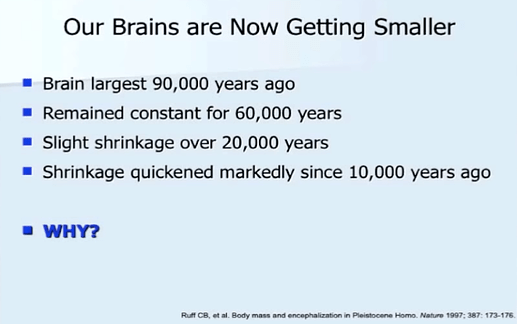Is the carnivore diet nutrient sufficient long-term? Published paper
If it isn’t then we wouldn’t be here now.
The arguments for plant eating always resolve to “we’re primates and all primates were and are plant eaters”. What always seems to get lost in the advocacy is that all of our primate relatives have/had big guts to digest all the bulk they needed to eat to get enough nutrients from plants. Hominids gave up the big guts to grow big complex brains. The big complex brains require a lot of energy all the time and plants can’t supply it. Especially during our Pleistocene evolution, eating meat and fat was the only way to get sufficient energy. It was in fact very fortuitous that our ancestors of 3-4 million years ago came down out of the tree and ventured out onto the dry plains of central Africa and adapted to eating what they found there: high energy, easily digested food ‘on the hoof’ in abundance. If they had not done so, humans would still be just another primate species chattering in the treetops of central Africa.
I think we were opportunists, though. If we had local sources of plants, we would have eaten them. If we traveled with the animals we were hunting, though, we would have to eat whatever is available, but this would have to be based on knowledge too. You don’t want to be the first to eat a previously uneaten plant.
Interesting podcast about our big brains evolving because of living near water and eating seafood.
After looking into becoming a ketonivare, my husband and I have decided not to go that way. We like our meat, we certainly do. But we also like our veggies, fruits, etc. and are of the mind that they were put here with good reason.
I’m not trying to sway someone one way or the other. Just making a point of some don’t do that.
Thank you for this link. It’s a very good and easily followed explanation. The dietary mess we’re in now and how we got here - far from the dietary state of our ancestors for more than 2 1/2 million years.
This one screen (29:00) displays the logic superbly:
This (40:25) is very interesting as well:
And this (45:00):
That would be the ‘aqautic ape’ hypothesis. Certainly, our ancestors who lived near water availed themselves of fish, shellfish, etc. We have archeological evidence, coprolites specifically that contain fossilized fish bones and fragments. But I think it a bit far-fetched to conclude that we grew big brains because some of our ancestors happened to live near rivers or coasts.
Look at the Mammoth Steppe topic I’ve linked above, particular the two videos in reply #3 of the general geography and biogeography of the Pleistocene. When our ancestors left Africa the journey was primarily overland. Those explorers ended up on the Mammoth Steppe. I think it far more likely that our ancestors followed the herds of mega fauna browsing and grazing the endless prairie where a single kill could feed the family or tribe for weeks or months.
The aquatic ape theory would apply much further back in time, our evolution into Homo sapiens. We would have already had our big brains by 30,000 years ago.
I would agree. Thirty thousand years is only 1.5% of human evolutionary history. Our large brains developed very early on.
I’m talking long before our ancestors left Africa (although it’s very possible that there was ‘co-evolution’ of primate/hominid species occurring approximately contemporaneously in east Asia and/or southeast Asia). Evidence currently suggests that our ancestors came down from the trees onto the surrounding savanna about 4+ million years ago. Most likely due to climate changes in east Africa that reduced the forests and increased the open plains. There was lots of potential food roaming around, but also lots of serious competition in the form of big cats who saw those funny looking critters running around on two legs as just another entree. Further evidence suggests our ancestors were eating meat/fat less than a million years after coming down from the trees. My bet would be they started eating animals shortly after leaving the trees because on the plains that’s pretty much all they had. And it’s very likely that they simply scanvenged the remains of big cat kills. So we’re looking at 3 1/2 million years ago when our brains started growing and our guts started shrinking.
The map I posted of the max range of the Woolly Mammoth circa 30-20 bce was simply to outline the probable full extent of the Mammoth Steppe, not to set the time frame for our evolution. Mammoths, or at least their immediate ancestors, and the steppe were there since the beginnning of the Pleistocene. In fact, the steppe developed in response to the climatic changes that produced the Pleistocene itself, as explained in the videos I’ve linked.
Our ancestors left Africa around or maybe slightly prior to the beginning of the Pleistocene, 2 1/2 million years ago. I doubt it took more a few hundred years or so (maybe a thousand years at most) for them to discover the Mammoth Steppe and the herds of mega fauna there. That because pretty much everywhere between the east African plains and the Mammoth Steppe was either mountains and/or too dry to support much animal life. Yes, some of them might have ended up on the east coast of the Mediterranean Sea, or what the eastern end of it looked like then (again see the video) or on the coast of the Indian Ocean. But my bet is most ended up on the Mammoth Steppe and that’s where the evolutionary action really took place.



